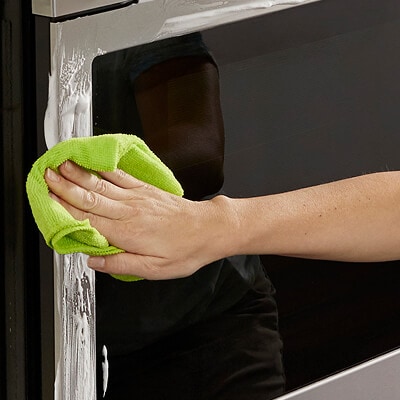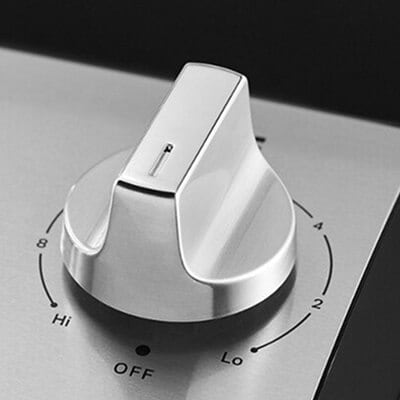
How to clean a glass electric stovetop in 5 easy steps
Wondering how to clean your glass electric stovetop or cooktop? Using the right cleaners and tools can help you get the benefits of cleaning, like a surface as free of stains as possible and a stovetop that functions without being hindered by food gunk. Follow these steps to learn how to clean an electric stovetop, like these electric cooktops from Whirlpool brand, and refer to your stovetop’s use and care guide for more details.
Got a gas range or cooktop? Follow the Whirlpool brand guide to cleaning gas stove grates and burners for great results.
Glass electric stovetop cleaning instructions
Using a cooktop cleaner on a regular biweekly or monthly schedule can help you battle hard-to-remove soils and help protect your cooktop from damage. You can clean your cooktop in a few easy steps, including clearing off stuck-on foods, cleaning off the glass surface, wiping down stainless steel components and cleaning stovetop knobs.
Supplies
Cooktop cleaner
A spray bottle of white vinegar (optional)
Baking soda (optional)
Tools
Cooktop scraper
Nonabrasive cleaning pad
A soft, dry cloth
Time needed
You can expect to take about 15-30 minutes to clean your cooktop before allowing it to dry.

1. Allow glass electric stovetop to cool
Allow your stovetop to cool until it’s only slightly warm. If there are some light marks or spills on the stovetop, you can spray it with white vinegar to soak as it cools.

2. Scrape off food residue
While the cooktop is still slightly warm, use a cooktop scraper at a 45 degree angle to remove any food residue. It’s recommended to wear an oven mitt while scraping the cooktop, and don’t substitute the cooktop scraper for tools like steel wool that would scratch the cooktop.

3. Clean glass surface with cooktop cleaner
Add nonabrasive cooktop cleaner directly to the cooktop, and be sure to always follow the label instructions on your cleaning products. Avoiding any stainless steel, rub with a nonabrasive cleaning pad and let the cleaner dry to a white haze. Next, buff with a soft, dry cloth until the white film is no longer visible.

4. Clean stainless steel surfaces
Use a stainless steel cleaner to clean stainless steel appliances, rubbed in the direction of the grain to help avoid damage. If you don’t have any on hand, you can dip a nonabrasive sponge into liquid dish soap diluted in water and scrub the stainless steel cooktop surfaces. If you use this method, rinse with clean water and dry with a soft, clean cloth. Do not use soap-filled scouring pads, abrasive cleaners, cooktop cleaner, steel wool pads, gritty washcloths or abrasive paper towels. When done, you can clean the sponge in the microwave.

5. Wash glass electric stovetop knobs
Pull each cooktop knob directly away from the control panel to remove, then wash them in your sink with water and dish soap. To help avoid damage, do not soak the knobs or remove the seals underneath. Dry and replace.
Shop Whirlpool® Cooktops with WipeClean™ Coating
Whirlpool® Cooktops help you stay on top of mealtime, even when life gets busy. Select models offer enhanced features that help bring speed and flexibility to your kitchen routine. Select models feature Temp Cook™ Induction Technology that helps you avoid burning with dual temperature sensors that monitor and maintain your heat, while other models, like this one from Whirlpool brand, are equipped with a convenient WipeClean™ Coating that simplifies cleanup so you can wet, wait, and wipe away the mess after meals.
Should you clean a glass electric stovetop after each use?
Cleaning up your cooktop every time you use it can help keep it looking good and operating as intended. Keep messes under control by wiping down the stovetop daily with warm water and a small amount of dish soap. Adding this simple and gentle process to your daily kitchen cleaning routine can help make kitchen maintenance easy.
How do you clean burnt-on spills from a glass electric stovetop?
A cooktop scraper is key to an easy cleanup. Tackle the spill by mixing a half-cup of baking soda and three to four tablespoons of water until it forms a paste, then apply the paste to the spill and scrape with a cooktop scraper. You can substitute cooktop cleaner in place of the paste.
Note that it’s important to clean sugary spills (like jelly, candy or syrup) right away. If sugary spills are allowed to cool, they can stick to the cooktop, causing permanent marks.
Shop Whirlpool® Induction Cooktops
Looking for a low-maintenance electric cooktop? Induction cooktops heat up and cool down quickly, letting you clean up an induction cooktop with ease. Learn more about how induction cooking works to see if it’s right for you.
Tips for cleaning a glass electric stove top
Help keep your glass electric cooktop looking clean with a few simple cleaning strategies. From everyday wipe-downs to deeper cleans for stubborn stains, these tips can help maintain a shiny, streak-free surface.
Start with a clean, dry pan to help prevent cooktop stains
Residue and water left on pots and pans can leave deposits when heated. If you already see deposits, clean your stove using a cooktop cleaner. The marks may not totally disappear, but can become less noticeable over time.
Use vinegar and a scraper for a quick cooktop clean
If you don’t have a special cooktop cleaning kit on hand, you can try scraping with a plastic scraper, spraying your cooktop with white vinegar and scrubbing with a nonabrasive cleaning pad.
Tackle tough stovetop messes with baking soda
Baking soda is a powerful cleaning agent that can help dissolve messes like grease, dirt and other stuck-on grime. Fight the toughest stains and spills by combining a half-cup of baking soda with three to four tablespoons of water. Apply the baking soda paste to your stovetop and let it sit for 20 minutes, then use a nonabrasive cleaning pad to wipe away the paste.
Shop Whirlpool® Electric Cooktops and Ranges
Whirlpool® Electric Cooktops and Ranges keep everyday convenience in mind. Select models feature an Easy-Wipe Ceramic Glass Cooktop. Other models include a Hot Surface Indicator Light that helps you see when the cooktop is still hot to the touch, even after it's been turned off.


Helping kids stay in school
Learn how Whirlpool helps end the dropout cycle by giving kids access to clean clothes through the Care Counts™ Laundry Program
Was this article helpful? Pass it on
Explore more from Whirlpool brand


home heartbeat
Ready for more tips, home hacks and appliance guides?






